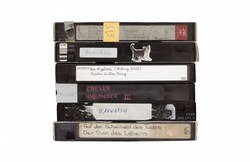xposit / one twelve. The Alumni Exhibition Series at the Academy of Fine Arts Vienna
With the new alumni exhibition series xposit, each semester alumni recommended by professors at the Academy will present changing exhibitions in the rooms of the Rectorate. The series will start off with three artists: Sarah Kienpointner, Jörg Reissner, Anneliese Schrenk.
Location, Office of the Rector, M 5
Greeter: Eva Blimlinger
Introduction to the work of Jörg Reissner: Erwin Bohatsch
Office of the Vice-Rector Teaching | Promotion of Earlystage Artists / Researchers
Greeter: Karin Riegler
Introduction to the work of Anneliese Schrenk: Gunter Damisch
Office of the Vice-Rector for Art | Research
Greeter: Andrea B. Braidt
Introduction to the work of Sarah Kienpointner: Mona Hahn
Refreshments after Presentation
Sarah Kienpointner
Sarah Kienpointner, born in Hall in Tyrol, study of fine art with Matthias Herrmann and Mona Hahn at the Academy of Fine Arts Vienna, graduation in 2011.
In her work BAYWATSH - Teilw. Ohne Ton, Sarah Kienpointner explores the habit of labeling video cassettes. Her collection consists meanwhile of 400 VHS cassettes and can be seen as a homage to an almost lost historical phenomenon. The focus is on the 30-cm2-size labels, individually inscribed by the owners. Along with formal characteristics such as affixed excerpts from TV-guides or especially the handwriting play an essential role through the information transported in the written word and also the associations thus evoked. One finds on the labels such things as sketches of an entire film epoch, meticulously recorded expressions, cryptic comments, as well as shows one had thought of as forgotten. Onomatopoeic phrases reflecting German phonetic spelling such as "Ice Wide Shot" or film combinations of, e.g., Auf den Schwingen des Todes (engl., A Prayer for the Dying ) on the same tape as Der Sinn des Lebens (engl., The Meaning of Life ) are the amusing peaks of the work, which allows us to nostalgically recall the twentieth century.

C-Prints, printed, in six parts
72 x 100 cm
The work consists of six large-format photographs and a publication in which the artist shows the entire archive of the odd cassettes. The video cassettes were scanned on a flat-bed scanner, and finally reworked and printed in their original sizes.
The chosen form of illustration refers to the digital processing of analogue archives and historical documents and makes use of a sober serial representational method in a documentary style.
Jörg Reissner
Jörg Reissner, born in 1984 in Vinschgau (Italy), study of fine arts with Erwin Bohatsch at the Academy of Fine Arts Vienna, graduation in 2010.

Acrylic, color print on paper, canvas
150 x 140 cm
Reduction and Concentration
The confrontation with space and area is a central theme in the work of Jörg Reissner. His pictures emerge from an overlapping of photography with color fields. By combining geometric forms in various color layers with spatial situations from the artist's environment, Reissner creates a level on which spatiality can be studied fragmentarily and newly defined.

Acrylic, color print on paper, canvas
50 x 40 cm
Small roughnesses such as a color drop here or an incompletely filled-in surface there, strengthen the dynamic of the works and characterize them as a presentation of painterly moments on a flat ground, while the image is made visible at the same time as a three-dimensional object in space.
www.joergreissner.com
Anneliese Schrenk
Anneliese Schrenk, born 1974 in Weiz (Austria), study of fine art with Gunter Damisch (2002-09), Veronika Dirnhofer (2003-09) and Otto Zitko (2007) at the Academy of Fine Arts Vienna, graduation in 2009.

Leather on stretch frame, nitric acid, shoe polish, wood stain
190 x 170 cm
At first glance the works of Anneliese Schrenk appear as monochrome color fields in a reduced tint. But quickly a flicker is detected and the surfaces are anything but monochrome. A texture which reflects the light can be recognized, through which black unfolds and green, gray, and purple shine through. A closer glance reveals that it is a property of the ground that calls the images to life. The effect is created through the choice of material: Anneliese Schrenk uses leather, for example, as her canvas and works with stains, acid, and shoe polish.

Leather on stretch frame
182 x 54 x 23 cm
The leather that the artist uses is described by manufacturers as "cast-off skins." They are not lucrative for the market since they reveal too many natural flaws, yet that is exactly what makes the material so interesting for Schrenk. The leather itself already contains drawings created during the course of the animals' lives; further tracks are left behind during processing, for example during tanning, sanding, and dyeing. The artist stretches the leather to the maximum size of the respective skin using right-angle stretch frames and places the canvases on the wall. While she does not further process the leather for the work Haut gebogen 1 , which is lifted up off the wall and projected into the room, she takes a further step with the work Säure 4 . The treatment with nitric acid causes the leather to shrink, to become porous, and the brittle surface forms a delicate relief.
Also in her paper works, Frottage/Schillerplatz3/Raum 113, Schrenk makes traces visible. The title betrays this; here she presents the skin of the Academy itself. In a graphite rubbing of the paper held against the wall, and by fixing the surface structure with shoe polish, she creates an artistic representation of her place of study.
http://www.annelieseschrenk.com
